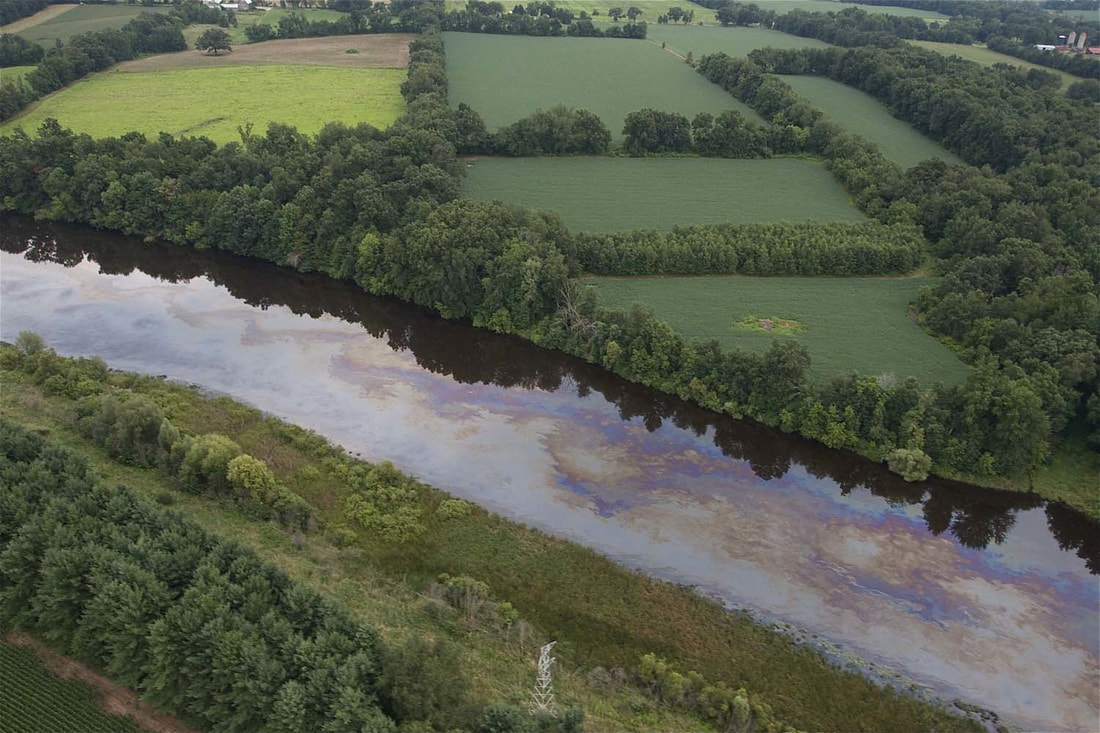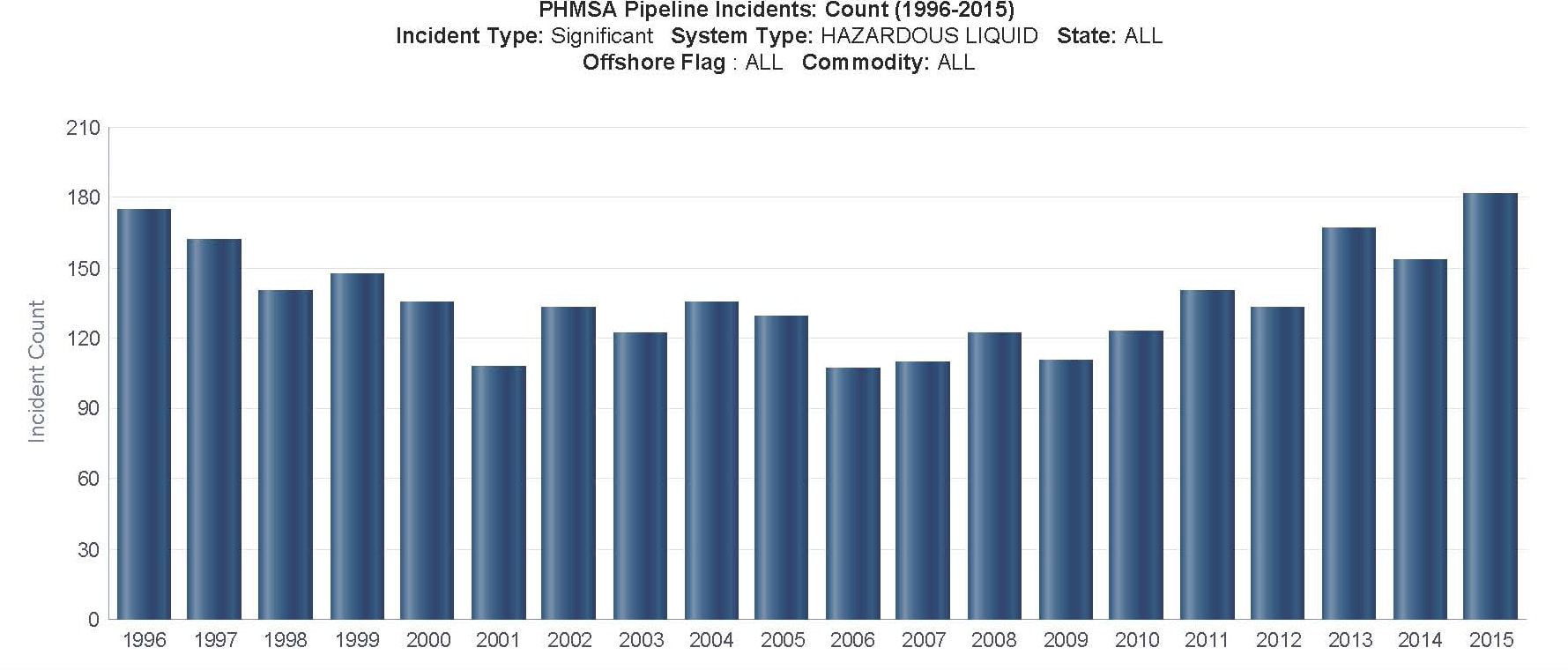Releases of products carried through pipelines can impact the environment and may result in injuries or fatalities as well as property damage. The risk associated with pipelines varies depending on a number of factors such as the product being transported in the pipeline, size and operating pressure of the pipeline, as well as the population and natural resources near the pipeline.
The risks associated with hazardous liquid pipelines depend primarily on the commodity and the characteristics of the surrounding area. Some hazardous liquids, such as propane, pose a near-term hazard of fire or explosion. Other releases, such as crude oil, have greater risks for the environment in both the short and long term. Crude oil spills can result in harm to human health and the environment, including injuries or fatalities to fish and wildlife, and contamination of drinking water supplies.
Waterfowl populations often experience direct mortality or significant injury from oil spills. For example, oil coats bird feathers reducing their buoyancy, and when birds groom themselves, they ingest the oil which will wreak havoc on their internal organs. Additionally, oil on the surface of water blocks sunlight, damages fish eggs, and impacts plankton, a primary food source for numerous fish and wildlife species. Oil can linger in the environment for many years, even after a cleanup, continuing to affect fish, wildlife, and humans. In addition to the environmental impacts of a spill, the potential economic impact of an oil spill in our region – from property damage to a decrease in tourism – would be substantial.

For natural gas pipelines, the greatest risk is associated with fires or explosions caused by ignition of the natural gas, This can cause significant property damage and injuries or death. Additionally, the release of natural gas, primarily methane which is a very potent greenhouse gas, contributes to climate change.
Aging Infrastructure
Over 50% of the nation’s pipelines were constructed in the 1950’s and 1960’s during the creation of the interstate pipeline network built in response to the huge demand for energy in the thriving post-World War II economy. Some pipelines were built even earlier. Over 12% of the nation’s cross-country gas transmission and hazardous liquid pipelines were built prior to the 1950’s. The oldest pipe still in operation in Michigan for hazardous liquids was installed during the 1930’s and for natural gas was installed prior to 1940’s. Each type of pipeline has its own unique age (and even material) distribution. The figure below depicts the percentage of pipelines constructed by decade (50s = 1950’s) for each of the three types of regulated pipelines.
Source: PHMSA
While aging infrastructure is a problem, age alone does not fully indicate the risk of a pipeline rupture. Factors such as type of materials used, installation techniques, seam type, whether corrosion prevention measures were used, and how the pipeline is maintained all impact the likelihood that a rupture could occur. While each of these factors can contribute to a pipeline’s risk, an operator properly managing the integrity of its pipeline system can counterbalance the impact of aging and construction materials.
A few construction materials in particular have been identified as high risk. Cast iron pipelines are high risk and are among the oldest energy pipelines in the United States. The degrading nature of iron alloys and pipe joint design have greatly increased the risk involved with the continued use of such pipelines. There are still approximately 27,000 miles of cast iron main gas distribution lines in the United States. Most are concentrated in five states – New Jersey, New York, Massachusetts, Pennsylvania, and Michigan. Michigan has more than 3,100 miles of these older pipelines crisscrossing the State. These pipelines are particularly susceptible to stresses from underground disturbances such as ground settlement, freeze-thaw cycles, soil erosion, and nearby excavation. In addition to cast iron pipelines, there are also some steel pipelines of concern. “Bare” steel pipelines were constructed prior to the requirement to provide a protective coating to prevent corrosion. Many states, including Michigan, have pipeline replacement programs to accelerate the rate at which operators replace the riskier pipes. However, operators only replace so many miles of pipeline per year. As a result, some of these replacement programs will not be completed for many decades.
Pipeline incidents
There are two types of pipeline incidents: leaks and ruptures. A leak is a slow release of a product whereas a rupture is a breach in the pipeline that may occur suddenly. In general, leaks are more common, but cause less damage as opposed to ruptures that are relatively rare, but can have catastrophic consequences.
There are a number of causes of pipeline incidents including corrosion, excavation damage, incorrect operation, material/weld/equipment failure, and natural force damage (i.e., Hurricane Katrina). Material, welding, and equipment failure is the number one cause of pipeline incidents, with excavation damage the second cause.
Pipelines are considered to be low risk/high consequence meaning that incidents are relatively rare considering the total mileage of pipelines and the volume of product transported, but when incidents do occur, they often have catastrophic consequences. Two examples of how devastating pipeline incidents can be include the 2010 gas pipeline rupture and ignition in San Bruno, California that resulted in 8 fatalities, injuries to more than 60 people, 38 homes destroyed, and another 70 homes damaged and the 2010 oil pipeline rupture that spilled approximately 843,000 gallons of crude oil contaminating over 35 miles of the Kalamazoo River in Michigan.
The Pipeline and Hazardous Materials Safety Administration (PHMSA), the federal agency responsible for pipeline safety, keeps track of pipeline incidents throughout the country. In the last two decades, pipeline safety has generally improved as there has been a downward trend in serious accidents. A serious accident is defined as an accident where there was a fatality or a number of injuries.
While there has been an overall downward trend in the last 20 years, there has actually been a slight increase in significant accidents for hazardous liquid pipelines in the last few years.
A Significant Incident is when any of the following specifically defined consequences occur:
- fatality or injury requiring in-patient hospitalization
- $50,000 or more in total costs, measured in 1984 dollars
- highly volatile liquid releases of 5 barrels or more or other liquid releases of 50 barrels or more (1 barrel = 42 gallons)
- liquid releases resulting in an unintentional fire or explosion
In Michigan, between 1996 and 2015, there were 37 significant incidents on hazardous liquids pipelines. Fifteen of those were crude oil spills. In 2015, there was only one spill in Michigan.






